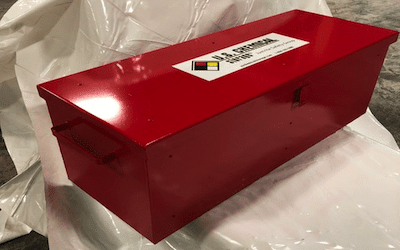Avoid Injury or Penalties with the Correct Explosive Storage Solutions
The
Bureau of Alcohol, Tobacco, Firearms and Explosives (ATF), is responsible for regulating ammunition and explosives in the United States. They laid out these regulations in the Federal Explosives Law and Regulations based on the Safe Explosives Act.
Part 555 of Title 27, Commerce in Explosives, covers ammunition and explosive storage.
Classes of Explosives
To determine the risks and requirements for different types of explosives, the ATF divided them into classes. The regulations define the classes of explosives in the table below:
| Class |
Description |
Example |
| High explosives |
Explosive materials, which can be caused to detonate by means of a blasting cap when unconfined |
Dynamite, flash powders and bulk salutes |
| Low explosives |
Dynamite, flash powders and bulk salutes |
Black powder, safety fuses, igniters, igniter cords, fuse lighters and display fireworks |
| Blasting agents |
Materials containing a mixture of fuel and an oxidizer |
Ammonium nitrate, nitrate-fuel oil and certain water-gels |
The class of explosive has a direct bearing on the type of explosive storage magazine acceptable for short and long-term storage. Construction materials, safety features, and proximity to other buildings are all clearly laid out.
SEE ALSO: ATF Explosive Magazine Construction Requirements
8 Rules for Storing Explosives
Before choosing an storage magazine, review the applicable ATF regulations. Aside from the physical requirements of the storage magazines, there are several practical requirements on record keeping and safety that also apply. Businesses should adhere to the following rules:
- Post a copy of the license or user permit at your premises. Make sure it is always available for inspection.
- Notify the fire safety authorities in your region by word of mouth on the day storage of explosives begins. Provide a follow-up in writing within 48 hours (555.201).
- Keep a daily summary of inventory at each explosive storage magazine in a storage facility or in a central location on the business premises (555.122, 555.123, 555.124 and 555.125).
- Inspect explosive storage magazines every seven days to identify any unauthorized access or removal of contents (555.204).
- Never permit smoking and/or open flames in any magazine, within 50 feet of an outdoor magazine, or in any room containing an indoor magazine (555.212).
- The maximum limit for any magazine is 300,000 pounds of explosive materials or 20 million detonators (555.213).
- Store detonators in separate magazines from other explosives, though there are some exceptions listed in the regulations (555.213).
- Consult the regulations for specific distances between storage magazines and inhabited buildings, public highways, or other magazines. Distances vary based on the amount and type of explosives in the magazine (555.218, 555.219 and 515.220).
RELATED ARTICLE: Protect High and Low Explosives with Explosive Storage Magazines
Contact U.S. Chemical Storage for Explosive Storage Magazines
U.S. Chemical Storage manufactures and supplies
magazines for storing ammunition and explosives. We produce both standard models and customized solutions for your explosive storage needs. Our technical experts will help evaluate your site conditions and advise you on the right magazine to keep you compliant with ATF regulations. Find out more about our explosive storage magazines
here.
References

